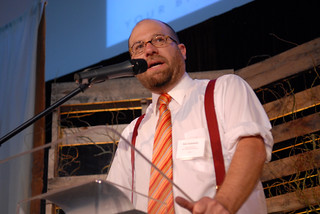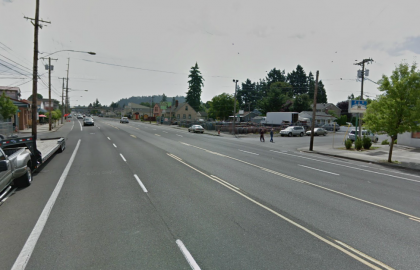
Sadowsky to discuss Vision Zero in more detail.
(Photo by J.Maus/BikePortland)
Yan Huang, 78, was crossing Division Street on Valentine’s Day with her 80-year-old husband, walking in an unmarked crosswalk from curb to rounded-off curb across five lanes of auto traffic. She never reached the other side; a man in a left-turning pickup didn’t see the couple and steered into them, killing Huang.
The next day, Saturday, a silver minivan, whose driver remains at large, left the scene of its fatal collision with a person on foot on Southeast Powell at 124th.
On Sunday, a man was killed in a car when the drunken driver he was riding with slammed into a utility pole at Northeast 102nd and Fremont.
Deaths like these make news, but they’re not new. About one in 50 Americans will die an automobile crash. What’s new is that Portland’s transportation director says the city can and will begin to do something systematic to change this.
Safety advocates are urging fast action. Early Monday morning Oregon Walks launched a #PDXVisionZero Twitter hashtag and a petition to urge the city to follow through on Director Leah Treat’s promise to move toward “Vision Zero,” the philosophy that there is no acceptable level of traffic fatality.
But is Vision Zero more than a buzzword? Are such deaths truly preventable? Is preventing them worth the cost? On Friday I asked street-safety advocate Rob Sadowsky, executive director of the Bicycle Transportation Alliance, to talk about this concept and what it might actually mean for Portland.
“I said, ‘This is our agenda; we’re going to want it to be your agenda.'”
— BTA Director Rob Sadowsky on Vision Zero, to incoming PBOT Director Leah Treat.
BikePortland: What do you think of city Transportation Director Leah Treat’s saying that Vision Zero will become part of city policy?
Rob Sadowsky: Great. It was one of the first things I talked to her about even before she came here. I said, “This is our agenda, we’re going to want it to be your agenda.” She’s been cautious from the beginning; it’s really exciting to see that she’s willing to put in in.
[Mayor] Charlie [Hales] had committed to it on the campaign trail, but we really hadn’t seen that vision play out in terms of implementation.
BP: The idea of Vision Zero is that every traffic death can and should be prevented before it happens. That’s more than just making efforts to make streets safer, right? Because every city does that — even as they’re building unsafe streets.
RS: We need to look at design, we need to look at level of service, we need to look at education and enforcement. We’re still making decisions based on [traffic] flow as a first priority, and Barbur is a good example.
We need to start those conversations about what that looks like with Multnomah County and other insitutions that have some control over our roads. We need to get the commissioner [of transportation] behind it; it can’t just be the bureau director.
BP: What’s a specific example you could imagine of Vision Zero in action in Portland?
RS: When the city makes decisions about temporarily adjusting traffic – around Timbers games, for example. [Former city Transportation Director] Tom Miller had this idea that you would take Burnside and bring it down to one lane near the park in order to accommodate the swells of pedestrians that are coming out of the park. The way we’ve been acting today is that flow is more important. The Vision Zero policy would say, “No, nothing is more important than the safety of those pedestrians.” The folks who are making decisions about even something like a detour or a temporary traffic management plan should be taking into account Vision Zero.
The Vision Zero policy really says, no matter what, we’re not going to tolerate a fatality. My perspective and what I think I just heard from Leah is, this is the only moral way to approach this.

killed Friday morning as she walked across the street.
(Image: Google Street View.)
BP: But could you really justify spending, to pick a ridiculous number, $100 million to prevent a single death? Because my understanding is that Vision Zero would say you should. That just seems to me like a worship of death — as if preventing death is more important than all the other things in people’s lives.
RS: I think it’s a question of what you value. For me it becomes personal. When I see families impacted by traffic fatalities, it seems preventable.
I’m not sure we can prevent all fatalities. Nor am I sure that we have the political will or, I don’t know, the chutzpah, to take some of the steps on the enforcement side. We continue to tolerate people driving while intoxicated or driving while distracted and give those people their licenses back. A Vision Zero policy within the city isn’t enough. We need it within the state and we need it at the DMV.
Not all these problems are systemic, and not all of them are going to cost $100 million.
BP: So is Vision Zero basically a managerial tactic that communicates to employees what they should be prioritizing?
RS: Yeah. I always think that planners, engineers, are some of the best problem solvers. If we define the problem for engineers as, “How do you move traffic through quickly?” they will make different decisions than if we define the problem as “How do we do it without the following consequences?”
I think it can also stand the test of common reason. Can you explain it to the general public? “If we take this step, it’s going to be safer.”
Qs & As edited for clarity and brevity. The views expressed in the Qs above are my own; you can read more about Vision Zero in our archives here and here. The Oregon Walks petition is here. -MA
